|
Monday, December 31, 2007
Progress Notes
One of the objectives of this page is to move around the county featuring interesting
historical items and people of these areas. One of these which I will feature today is the
Mt. Carmel Baptist Church region which lies between Eldon and the Wright's Creek Bridge on
Highway 54. Actually, this area follows north to south the old Missouri Pacific railroad
spur which followed a southerly path from Eldon to where the line turned west near the
Wright's Creek bridge going to Old Bagnell. On the east the area is bounded by Highway 54
and on the west by the Rocky Mount area. You can enter the middle of the area by turning
west off Highway 54 on Mt. Carmel Road where the old Mt. Carmel church (photo 01) was located.
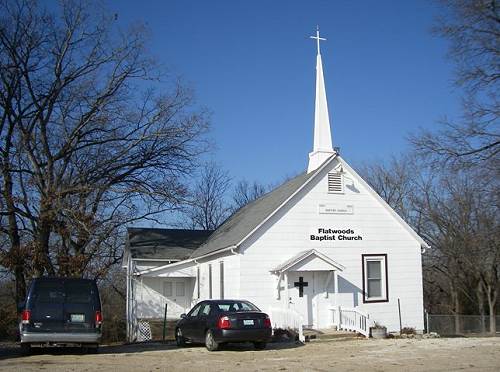
01 Mt. Carmel Baptist Church - Original Location
(Note: I know this is confusing but the original Mt. Carmel building shown in the photo
is now occupied by the Flatwoods Baptist Church group as indicated by the sign above the
door in the photo; a Mt. Carmel Church group now worships in the building formerly used by
the Bagnell Baptist Church at the junction of old and new Highway 54).
A short distance west was once located the old Mt. Carmel Cooper railroad train stop.
The Cooper School was located in this area. You can read more about Cooper School on our
own website at: http://www.millercountymuseum.org/schools/orsp.html
Once you get to this site just click on the Cooper School listing which is located at
number 28.
The source of my information today, Pauline Vaughan Stanton (photo 02 and photo 03),
is from one of the original families of the area.
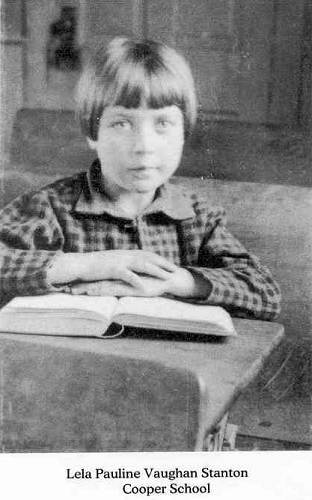
02 Lela Pauline Vaughan Stanton as a young girl
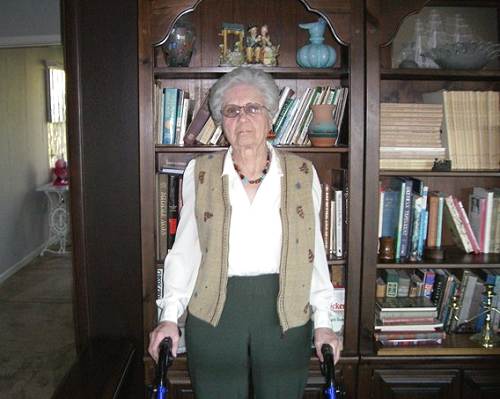
03 Pauline Vaughan Stanton - Recent Photo
Pauline wrote a couple of articles for the local monthly periodical,
"Lifestyle/50," in October of 1992 and February 1993 in which she described
interesting and personal details about what it was like to live in this area in the 1930's
and before. Pauline went to the Cooper School as did her father. In this school photo
taken in 1910 (photo 04) you can see
Pauline's father, Wesley, first on the left in the second row; and in the next photo, for
which we don't have a year (photo 05),
Pauline is standing in the second row in eleventh position. In the next photo (photo 06) is a picture of the school. These
photos are on our website but I am placing them here also for convenience.
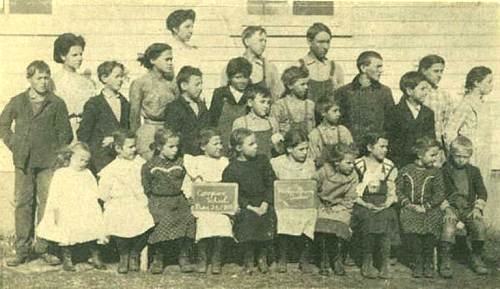
04 Cooper School - 1910
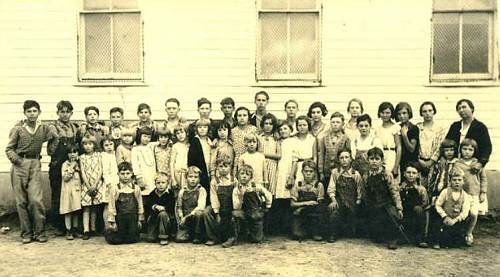
05 Cooper School - Early 1930's
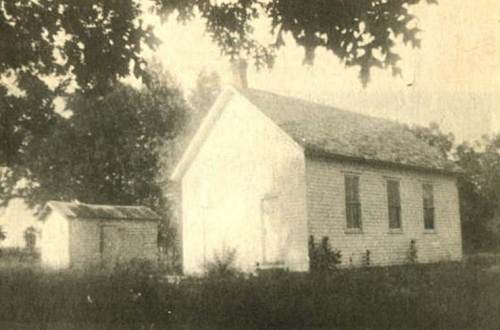
06 Cooper School
In an earlier edition of this page I featured Pauline's husband, Lon Stanton, in my
series about the cedar wood craft industry of Miller County. You can review this article
if you wish by going to the archives at the bottom of this page and clicking on the President's Message for 10/22/07. The following is
an amalgamation of the two articles mentioned above written by Pauline about her home area
around Mt. Carmel. Because it was written more than fifteen years ago, some of the farms
mentioned have changed owners and some of the people named have passed away:
Mt. Carmel Area
Pauline Vaughan Stanton
As we peruse history books, it seems Miller County was
not a bad place to live through the Great Depression years of the 1930s. Nationwide, many
would have considered it a privilege to have joined us here. In 1928, Herbert Hoover had
declared, apparently with good reason, "We in America today are nearer to the final
triumph over poverty than ever before in the history of any land." Fourteen months
later came the crash of the stock market. In 1932 the Southern Pacific ejected 683,000
trespassers seeking shelter in its cars, most of them young men from 16 to 25. By the end
of the year, the railroad had surrendered to the "Vagabond Army" and was adding
empty freight cars to accommodate them. Literary Critic Edmund Wilson reported,
"There is not a garbage dump in Chicago which is not diligently haunted by the
hungry."
Most Americans escaped such extreme privation, but there
were few who did not know the fear that their turn might come next. Among the unemployed
on Detroit's relief rolls, Mayor Frank Murphy reported, were doctors, lawyers, 45
ministers and "two families after whom streets are named." The baseball writer
Rud Rennie recalled his journey north with the New York Yankees from their training camp
in 1933, "We came home that year through Southern cities which looked as though they
had been ravaged by an invisible enemy. People seemed to be in hiding. They even would not
come out to see Babe Ruth and Lou Gehrig. Birmingham, a once thriving, bright metropolis,
looked as if it had been swept by a plague."
The construction of Bagnell Dam and the jobs provided in
the subsequent operation of that facility was an important factor in the economy
hereabout. Some locals who assisted in building the project put aside a portion of their
earnings and that made life easier for a brief time. The number of Missourians employed in
the venture is listed by one source as 5,799. The Missouri Pacific and Rock Island
Railroads still furnished some good jobs as did the Highway Department. The hamlet of
Eldon was a progressive trade center prior to the reality of the dam so long spoken of as
a possibility. The Lake began to fill February 2, 1931. Our immediate neighborhood in the
vicinity of Mt. Carmel Church did not benefit in a large measure from Roosevelt's relief
programs, but programs were in place for those who qualified. Most residents owned a bit
of land, a roof to shelter them from the elements and means to provide provisions to keep
one from hunger and cold. A severe drought was present, however, especially in Kansas and
Oklahoma. There were times when you could see part of another Kansas farm blowing through
Miller County and that served as a reminder that conditions were bleak elsewhere. The dust
was, at times, enough to be an irritant to the eyes and lungs and cause laundry not to be
hung on the line to dry.
There are many who would not call for an encore of the
1930s, but this area fared far better than some. When history books are written, they will
leave little doubt that changes brought to the area by the formation of Lake of the Ozarks
were of the first magnitude; but having said that, there was life here before Bagnell Dam.
Aurora Springs and West Aurora are absent from the 1934
official road map of Missouri. However, in 1892, Olean, West Aurora, Eldon and Aurora
Springs were connected by telephone. According to Schultz's "History of Miller
County", Aurora Springs was the largest town in the county during the 1880s and 90s.
In 1881, the town had a "boom" as the result of the discovery of mineral
springs. About twenty new buildings including stores, hotels and dwelling houses were
erected that year. In 1890 the town had a population of 421. Merchants were Wellington,
Alten, J.C. Driver, Harvey and Simmons, C. Laswell, H.L. Miller, H.P. Moles, Peterson
& Co., J.P. Stevens and Stevens and Cross.
The Goodspeed "History of Missouri Counties"
part 2, states "it would be remiss not to list Dr. G.W. Tremain as a prominent
citizen of Aurora Springs. Dr. Tremain was born in Ohio in April 1845, moved to Miller
County on December 18, 1869, purchased 160 acres of land, lived there sixteen years,
moving to Aurora Springs in 1885. Dr. Tremain specialized in diseases of the eye and ear,
also cancer diseases."
No railroads were built in Miller County prior to 1880.
The Missouri Pacific to Bagnell was surveyed in the winter of 1881-82. The first Missouri
Pacific depot was built in Eldon in 1882. The beginning of the lack of interest in Aurora
Springs began with the building of the St. Louis, Kansas City and Colorado railroad
through Eldon with the first trains on this line reaching Eldon October 22,1903. Earlier,
it was thought this railroad would be built through Aurora Springs.
The Aurora Springs City Park was a well kept park into
the 1920s and beyond. The park was nestled between the highway and a verdant hillside with
an artesian well flowing for all to enjoy. As a youngster, I was told of the remains of
the foundation for a sizable health spa atop the hill southwest of the park. When the
railroad missed the town the project faded into oblivion.
To this day, it seems to me there was some magic in
those steam locomotives that made their way through the farm owned by my grandparents on
the way to Bagnell and back to Eldon. The whistle of the trains seemed musical and I liked
to see them "let off steam." For a number of years more railroad ties were
shipped from Bagnell than any other location in Missouri. Certain trains would take you
aboard as a passenger any place along the line - you just stood beside the track and gave
the engineer the proper signal as the train approached.
My grandfather, Albert Columbus Vaughan, brought his
family to Miller County from Arkansas in the early 1900's, probably about 1902. The family
traveled by horse and wagon and settled near the Mt. Carmel Baptist church on what is now
Mt. Carmel Road about a mile west of the church. My father, Wesley Columbus Vaughan, who
was born in 1901, made the trip as a young baby. I was born and raised on a farm just east
of the original homestead near the Mt. Carmel Road.
We know my great grandfather, Lawson Thacker, already
was in this area of Miller County by reference to land deeds from the year 1883. In 1904
he gave a Quick Claim Deed to trustees for Mt. Carmel Church, trustees being Daniel F.
Slaven, Elisha V. Stark and J.M. Boan. My family was involved from the beginning with the
Mt. Carmel Baptist Church.
(NOTE: read more about Mt. Carmel Baptist Church on our own website at: http://www.millercountymuseum.org/baptist.html
The churches are listed alphabetically so you will have to scroll down the page to read
the history of this church)
In 1939, my parents sold to Curtis and Gladys Beach the
ten acres, more or less, adjoining Mt. Carmel Church. Balance of that acreage is owned by
my sister and her family. My brother has the area owned by my grandparents and later by my
parents. The husband of a cousin owns the other land that was part of the compound. Lawson
Thacker and his descendants lived on what became known as the John and Elizabeth Thacker
Boan farm for four generations. The place was sold outside the family recently. New owners
from Texas are preserving the barn and preserving and enhancing the house.
In 1938, my grandparents, Albert and Minnie Vaughan,
purchased a home with acreage next door to the Coffman Store on Highway 54 near Mt. Carmel
Church. My parents then moved to the original homestead that had been home to my
grandparents since 1901. It was from this place that Uncle Clinton (Elmer Clinton Vaughan)
left for service in World War I. He served in France and died in Base Hospital 27, APO733
at 5:20p.m. November 16, 1918 of influenza and bronchopneumonia. He was buried overseas
and later returned to Miller County under the direction of Phillips Funeral Home of Eldon.
He lies at rest in Dooley Cemetery.
In the mid 1940s, a farm was available that my
grandparents held in esteem and they were pleased to take possession of the property. The
home was built by the Giddens family. There, the parents of my father remained among good
neigh- bors to the end of their days. Grandpa died at home being 86 years of age. Death
came to my grand mother at age 91. She died in Humphreys Hospital at Tuscumbia after
spending a short time in the nursing home in Versailles. At grandfather's death all
grandmother asked of her children was that she be allowed to remain in her home. This home
was located in a community where lived, then as now, the Allen families. Charles and
Stella were of my grandparents generation. The home of the senior AlIens that I remember
as a child stands today in a valley with spring water flowing at one edge and there,
watercress grows with abandon. The setting seemed to my youthful eyes, as it does today,
to be waiting for an artist with brush and palette...
As the Allen children established homes of their own,
most located just around a bend in the road but some distance apart. The three eldest sons
were in the age range of my parents. There was one daughter and two other sons. For at
least four generations, this area has been Allen country. When you head southwest from
that neighbor- hood, you are in what was the Wood Compound. The Wood family arrived in
Miller County long ago. Seems there was Henry Tolbert, Sr. then Henry Tolbert, Jr. The Tol
Wood Cemetery is today well cared for and some of the graves date far back in time. I
remember brothers Sterling and Sam and their niece Grace. There was a Lannie who was a
friend of my fathers and may have been a nephew. Sterling was the epitome of a southern
gentleman in appearance and demeanor. In season flowers bloomed 'round about the two story
white frame house. Brother Sam lived alone in rather primitive conditions, at one time
excavating for himself a swelling in the side of a hill. In retro- spect, that cave was
likely Sam's version of an earth sheltered home. He owned land and planted a large truck
patch from which he derived much of his cash income. His knowledge of plants would cause
us today to refer to him as a horticulturist. The crop that made the big impression was
the melon patch. Watermelons and muskmelons were grown by the acre for selling and for
sharing. When you went to purchase melons, it was Sam's custom to serve you a sample of
his wares, so you always took with you a knife for carving as Sam did not excel in good
housekeeping. This past autumn I drove through the glen of the location of the melon
patch. It was a pleasant drive. A hay crop had been harvested and all looked peaceful and
orderly. The white frame house was destroyed by fire a few years back. When Sam was an old
man vandals one year destroyed much of the melon patch and he never again planted so large
a field of melons. Only one member of the Charles Wood family survived the influenza
epidemic of 1918. Daughter Grace became the wife of Julius Fitzgerald and lives today not
many miles hence.
Near the Wright's Creek bridge on the road that is a
short cut to Tuscumbia lived the family of William and Emma Sandfort. Don't remember one
thing about the crops grown on that land, but once you had been a guest there, you always
remembered the graciousness shown by Mr. and Mrs. Sandfort to the friends their children
invited home with them.
At the Wright's Creek bridge going in the direction of
Eldon via the railroad was the Wright homestead. Longtime back and when it was autumn, Mr.
Arey Wright was often seen with his horse drawn wagon laden with hickory nuts and black
walnut and other wares making his sales trips. Seated beside him in the spring seat of the
wagon was his faithful White Spitz. The Wrights raised White Spitz's for sale but gave up
each puppy with reluctance. When the two Union Electric villages were new settlements, Mr.
Wright and his dog were often seen going door to door like an early day peddler, but his
wares were not bottled or boxed. He also made his way across Bagnell Dam to the new town
of Lake Ozark and the man and his dog were recalled long after the sales trip became a bit
of local history.
During my childhood, we were often invited to the Wright
home and it was tradition to go there for lunch when mulberries hung ripe on the tree and
be served mulberry cobbler. The tree was of such proportion and the area it shaded so
extensive that one felt it must have stood in that location since time began. In the
corner of the vegetable garden was a large planting of horseradish and Mrs. Wright shared
roots with my mother. Chopping onions can bring tears to the eye but cannot compare to
grating horseradish.
Daughter Grace recuperated from tuberculosis in the
home. Health care procedures were faithfully adhered to and Grace recovered to live to an
old age. To my knowledge, no one else in the neighborhood fell victim to the disease at
that time. Mr. and Mrs. Wright were the age of my grandparents and it was a special treat
to visit their home. Mr. Wright wore a bushy white mustache and my grandpa Vaughan a bushy
red one and I suppose to a child that denoted some kind of kinship.
When you lived in a house beside the railroad on the
Missouri Pacific spur line from Eldon to Bagnell in the twenties and early thirties,
occasionally a hobo knocked at the door to politely inquire for chores he could perform in
exchange for a meal: My mother's parents lived just south of West Aurora where Highway 54
and the railroad ran side by side. There was a depot there and trains slowed or stopped
there so it was easy for the hobo to leave his freight car with safety at that point. Some
four miles down the track, my aunt and uncle dwelled close by the rails. Their home was
one and one-half miles south of Cooper Station where trains hesitated, making it a
convenient jumping off place. As the railroad terminated only a bit farther, hobo traffic
was not heavy enough to be a nuisance. Splitting wood to fuel the kitchen range was a
chore often assigned these guests for you must keep on hand a good supply of seasoned wood
for the cook stove, even in the midst of summer. While split wood was being added to the
stockpile, a meal was prepared, often being country cured ham, fried chicken or catfish,
provided there had been a recent outing to the river by the man of the house.
Refrigeration was not then as we know it today. The
springhouse was a great help, but you could not go to the freezer, take out a roast or
pork, chop and pop it into the microwave. But, it was possible to wring the neck of a
young chicken and prepare same for frying in record time. Because of keeping qualities
layer cakes, fruit cobblers and pies along with loaves of homemade bread were more or less
staples in the household. It would be interesting to know whether or not hobo culture had
a communications network as to where the tastiest meals would be served, for at some stops
they received only a handout. In his youth, my mother's older brother, Edward, traveled
the hobo circuit quite a lot and he encouraged the family to extend to these wayfarers a
courteous welcome. Edward died before reaching the age of thirty and many a hobo did not
know the meal they were served was, in away, a tribute to his memory. As to my life in
Miller County in the twenties and thirties, perhaps Mark Twain said it best when he said
of growing up in Hannibal, Missouri. "We were poor, but we didn't know that. We were
comfortable and happy and that we knew well."
After Highway 54 relocated to pass very near the front
door of Mt. Carmel Church, there came to our neighborhood a small grocery store. It was
across the highway and a tad to the north. This place is today, the home of Annie and
Geneva Meredith. The Coffmans' had lived on that farm for years and took advantage of the
re-routing of the highway to become roadside merchants. The store was a convenience to the
neighbors as it was to the wayfarer.
Not everyone living along the Cooper Station- Mt. Carmel
Road depended on the land to provide all the income for the family but farming was a good
way to supplement revenue from other sources. The fields in this section are small parcels
and not as fertile as river bottom land but if planted and tended, they will yield a
harvest.
Young men of my father's generation went to wheat
harvest in Kansas, as did my older brothers. Considerable wheat was grown in Miller
County. By Kansas standards, the amber grain was planted in mighty small fields at times.
Sam Buckner owned and operated threshing equipment. As a child, I heard the whistle of the
steam engine; I guess that sound would not be classed as melodious, but it was most
welcome to the ears of a youngster for it signaled all the excitement that went with the
threshing of the wheat. Of all the equipment that made up the threshing assemblage, I
thought the water wagon to be the most magnificent. All the equipment was well kept and
pleasing to the eye. I do not recall breakdowns interrupting the process. The equipment
was set in place at the desired location for the straw stack and the sheaves of wheat were
brought by wagon to the thresher. We harvested wheat but a few times on our acreage but on
the adjoining farm belonging to my father's aunt there was a straw stack of such
proportion as to suggest year after year of wheat harvest. Cattle ate openings into the
stack that became tunnels you could walk in and explore.
The farm wife served meals for the entire crew and each
lady of the house labored to make certain her feast measured up to the best of them.
Sorghum cane was grown in Miller County. My parents
planted a small patch to assure that we had enough to make molasses for our needs. The
cane must be harvested at the proper stage of maturity to insure a good product. Guess
doing it wrong would equate with biting into a sour green apple when you expected a sweet,
juicy one. The cane had to be stripped of leaves while standing and this was not
considered a fun job as you worked in close quarters and the leaves scratched then you
itched. The cane was then cut and hauled to the mill for processing. The power to grind
the sap from the cane was real live horse power. For molasses to be really good quality,
the sap had to be cooked at the proper temperature for the proper length of time and
stirred at just the right moment.
Our family asked that our molasses be cooked a little
extra to make it thicker. This was done and the color was a dark golden amber. When I see
the color of some molasses in the supermarket today, I say to myself there are people who
have never tasted properly cooked molasses. In winter, when a fresh supply was needed, you
had to remember to bring it in from the smokehouse the night before, or it would be too
thick to pour should you want hot biscuits and butter with molasses for breakfast. It
outclasses waffles and syrup every time. My Uncle Leslie was the best sorghum maker in the
territory and was well known for the fine job he did. The art is now a matter of family
history as no one else mastered the technique.
A short distance from the location of the molasses mill
was a beautiful spring. I remember that region before any ponds had been dug. The spring
had but one large cedar tree growing near the perimeter and it furnished shade so that you
could rest on a sunny day and observe the activity of the water as it bubbled up through
the sandy, bottom. I'm certain we had as much respect for the spring as did the Indians
who must have visited there long before the white man came. Many ponds are now in that
area. I don't know that trout raising was ever tried but the water coming from the spring
should have been cold enough for that purpose. The larger ponds at a much later point in
time did support catfish. In the early thirties, the first oblong ponds were dug and
minnows to sell to the bait trade were housed there. Minnow traps were set in the streams
nearby and the catch brought to the ponds to hold for market. That valley was good for
fish worms too. Seems you just had to put a spading fork into the ground, turn it over and
harvest the worms. At the time, the minnow and worms bait business was operating in the
Flanders Cave on the Jim Pruitt farm, and it was open to the general public. I do not
recall the length of time these ventures continued.
Some people along the Cooper Station-Mt. Carmel Road
kept flocks of laying hens and marketed eggs by the case, but should you have a flock to
supply family needs and a few extra eggs were produced, you could sell as few as one dozen
at the Farmers Exchange in Eldon. Same was true of thick sour cream. They would buy
one-half gallon should you have no greater amount to spare.
Live chickens could be sold by tying the feet so they
would be hobbled, and taking them squawking all the way to the market. The Farmers
Exchange was a busy, noisy place at the end of the week.
The Cheese Factory in Eldon ran a route to pick up whole
milk. You took the milk to the road and the usual pick-up spot was by the mail box. Milk
cans were numbered and the empty cans returned at the next day's pick up. Some grew extra
vegetables in the garden and town folk liked to come to the garden to make purchases. My
grand- father kept bees and it was a fun time when he "robbed the bees." Don't
think he had much honey to sell as he always shared with the two families of
grandchildren.
Tasks to be done around home fell into categories. Some
were looked forward to with enthusiasm, some were so-so and some just plain had to be
done. Laundry and dish washing fell into the had to be done group. Gathering eggs from the
nests in the hen house was a so-so job, but robbing the guinea hens nest was an adventure.
Guinea hens like to hide the nest in a brush pile or some out of the way place and you
used a long handled enamel ware spoon to retrieve the egg. Guinea fowls do not like snakes
and no snake can sneak into their territory without setting off the guinea alarm. Guinea
fowls can produce more noise pollution per ounce of body weight than anything else. We
never stewed a guinea and never sold one, and I don't know how we parted company, but
there came a time when they were no longer part of the scene. There seemed always to be
ducks and geese about and they were plucked for feathers and down at the proper season.
Feather beds made for cozy sleeping on winter nights and if someone was allergic to
feather pillows we just did not know what the problem was. Turkeys were novelties on our
place and no effort was made to raise them in quantity, but one year there was a huge
white gobbler who was caught by predators.
The duty of turning the cream separator was not a bad
job but washing it up after use was just plain work. Churning butter was an alright
assignment. but working the moisture from the butter with the wide wooden paddle was a
good job. No metal spoon served the purpose, you just needed that special shaped wide
paddle made of wood. Pressing butter into the one pound round mold and getting the pretty
design on top just right was a fun job. The round, covered, high-domed, glass butter
dishes were made to hold this work of art. The oblong one pound butter mold was practical
but was shy on art work.
Feeding the pigs was a so-so chore for they are clever
creatures, especially when you can observe them and leave them behind squealing in the
pen. Our pig pen had a rather steep incline of some distance from the feeding spot down to
the wallowing pit and unless the wind was in your face, it did not even smell bad.
Butchering day was at one and the same time dreaded and looked forward to. That day
provided good food almost immediately, and for months to come. The smoking and curing
process was a task my grandfather did very well. So well in fact, that more than one time
my grandparents returned from Sunday Services at Church to find the hams and bacon that
had been hanging in the smokehouse when they left home were no longer there. However, it
was interesting that nothing was ever taken until the curing process was complete!
Milking the cows was a chore not worth mentioning but
for the mysterious behavior of a Holstein called Mulie. That old cow would be the model of
proper cow conduct for days on end, then one day, give one violent kick that sent milk
flying all over the stall and its occupants. I thought Jersey cows to be more gentle and
more reliable.
One Sunday morning, a distant neighbor who taught the
adult Sunday School class failed to appear and as prior notice had not been given, it was
cause for concern. Friends inquired at his home and were told by the people on the
premises that Charley had taken a trip and they were looking after things for him. As time
went by, friends were certain something was amiss and an investigation began. When the
body of Charley Babcock was found buried at the end of his barn, the area was in shock.
The case unfolded and the man who reported that he was caring for the farm was tried in
Miller County and was sentenced to life in prison for the crime.
Traveling from Mt. Carmel Church toward Cooper School,
there lived Vaughans, Parsons and Summers for a time, Boans, more Vaughans, the Pruitt
families and the Coopers. Just to the left of the trestle over Highway 54, one found the
Dusenberry family. Backtracking and off the main road, but beside the railroad, lived for
a time, the family of Jess and Mary Strange. They were my grandparents nearest neighbors
and I do not remember when they moved away.
It was a good place to spend the early years of life.
Robert Louis Stevenson was a childhood friend. Among my favorites were, MY SHADOW, BED IN
SUMMER, THE LAND OF COUNTER PANE, THE LAND OF NOD, THE COWARD and THE LAMPLIGHTER. Don't
know how old I was before I knew that THE SWING was not; written about the swing hanging
from the giant oak tree in my own backyard!
Thanks Pauline.
At the museum we are working with some consultants regarding interior layouts and
designs. New office furniture has been ordered for the research area as well as shelving
some of which already is in place. A significant redesign of the interior of the original
building is planned as well. Everything will be completely different when we reopen next
spring. I am grateful for the many comments we are getting regarding the website. Quite
frequently someone finds it for the first time and becomes excited that they can read
about their family and place of origin all in one place. If you are a descendent of Miller
County ancestors from the past and find we have nothing about your family on our site,
perhaps you have some information of interest you would like to send us. These submissions
are placed in alphabetical order under the "Yesterdays" dropdown box at the top
left of the home page in the "People" section, many of which were written by
family members. The easiest way to get information to us is by our email address listed on
the home page. Snail mail is fine as well since we don't have any particular time frames
to meet; we are always looking for new ("old") information.
That's all for this week.
| 


